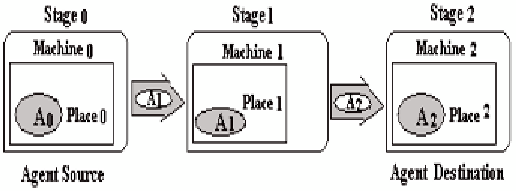Information Technology Reference
In-Depth Information
Model
We assume an asynchronous distributed system, that is, there are no bounds on transmission delays of
messages or on relative process speeds. An example of an asynchronous system is the Internet. Pro-
cesses communicate via message passing over a fully connected network.
Mobile Agent Model
A mobile agent executes on a sequence of machines, where a place
P
i
(
0
≤
i
≤
n
) provides the logical
execution environment for the agent. Each place runs a set of services, which together compose the
state of the place. For simplicity, we say that the agent “accesses the state of the place,” although access
occurs through a service running on the place. Executing the agent at a place
P
i
is called a stage
S
i
of
the agent execution. We call the places where the first and last stages of an agent execute (i.e.,
P
i
and
P
n
) the agent source and destination, respectively. The sequence of places between the agent source
and destination (i.e.,
P
0
,
P
1
, …
P
n
) is called the itinerary of a mobile agent. Whereas a static itinerary is
entirely defined at the agent source and does not change during the agent execution, a dynamic itinerary
is subject to modifications by the agent itself.
Logically, a mobile agent executes in a sequence of stage actions (Figure 1). Each stage action consists
of potentially a multiple set of operations
op
0
,
op
1
,…
op
n
. Agent
A
i
(
0
≤
i
≤
n
) at the corresponding stage
S
i
represents the agent that has executed the stage action on places
P
j
(
j
<
i
) and is about to execute on
place
P
i
. The execution of
A
i
at place
P
i
results in a new internal state of the agent as well as potentially
a new state of the place (if the operations of an agent have side effects, i.e., are non idempotent). We
denote the resulting agent
A
i+1
. Place
P
i
forwards to
P
i+1
(for
i
<
n
).
f fault Model
Several types of faults can occur in agent environments. Here, we first describe a general fault model,
and focus on those types, which are important in agent environments due to high occurrence probability,
and those that have been addressed in related work insufficiently.
•
Node failures:
The complete failure of a compute node implies the failure of all agent places and
agents located on it. Node failures can be temporary or permanent.
Figure 1. Model of mobile agent execution with three stages

Search WWH ::

Custom Search